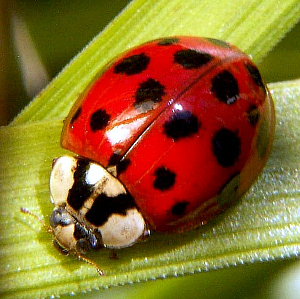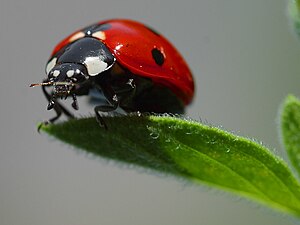Do Ladybugs Bite?

- Image via Wikipedia
To set the record straight, the simplest answer is NO they do NOT bite. That is the case for our domestic ladybugs and lady beetles, most commonly found in North America.
However, the multi-colored Asian lady beetles DO bite. Their native habitat is northeast Asia. However, the U.S Department of Agriculture, introduced the Asian lady beetle to California, back in 1916, to control aphids on pecan trees. Shortly after this release years ago, they promptly disappeared. Due to accidental transport, subsequent release, and natural migration, the Asian lady beetle is now found throughout the United States, along with more than 400 other species.
The Asian Lady beetle, is quite effective at controlling soft-bodied pests such as aphids, mites and scale, that are most commonly found in agricultural and domestic garden settings. The mature lady beetles, and their larvae consume hundreds of aphids and pests daily, thus earning their keep and proving their worth as a natural predator.
It is the Asian lady beetle, that is considered a nuisance. These are the ones who commonly invade our homes over the winter to hibernate, stain our cloths, and yes they can and do bite us!
In some cases of infestation, it is possible to have an allergic reaction to the multi-colored Asian lady beetle. Prolonged exposure to such infestations has been reported to cause allergic reactions in some humans (Yarbrough et al 1999, mangnan et al. 2002). Some patients have described itchy nose and eyes, sneezing, upper respiratory symptoms, and severe, or persistent asthma. This is so unfair, to our beautiful non-biting domestic US ladybug.
The Asian lady beetle and the domestic ladybug appear to be identical. Yet, there is one important way to tell the difference. Looking down, from an above vantage point, on the section of the Asian beetle, that separates its tiny head from its winged area, there is a distinguishing mark, that looks much like the letter “M”. Domestic ladybugs, do not have this characteristic.
If an Asian lady beetle lands on your skin, they are most likely there to explore for moisture or food. You may experience what feels like a bite, however, even most Asian lady beetles do not bite. It is more of a nibble, that is felt, and they do not break the skin, like most other biting insects do. They do however, have spurs on the back of their legs that can cause a poking, or pricking sensation, as they are scouting for a meal.
It is good to know that there is no known toxin or disease associated with this activity. If you are particularly sensitive, you may experience some minor pain or swelling associated with this “nibbling.” So, if you do come upon being nibbled on, please don’t blame the innocent ladybug. It’s after all, her look-alike, the Asian lady beetle!















![Reblog this post [with Zemanta]](http://img.zemanta.com/reblog_e.png?x-id=5d416390-622d-4328-afde-eaa7e441e998)


![Reblog this post [with Zemanta]](http://img.zemanta.com/reblog_e.png?x-id=b8fb2794-069a-4c3b-99f0-c57a8f508c79)